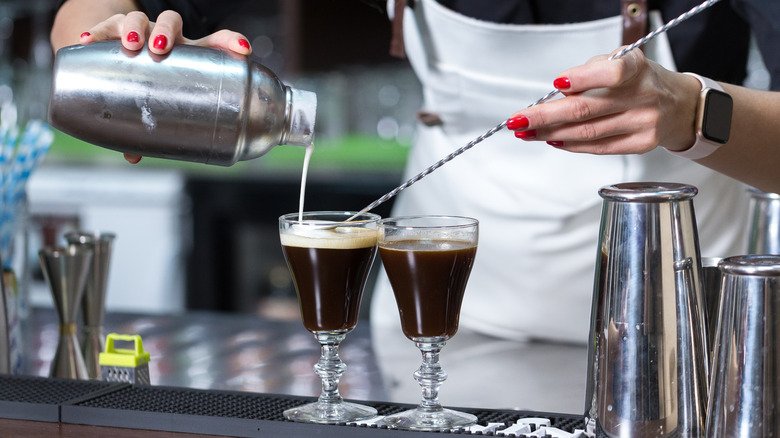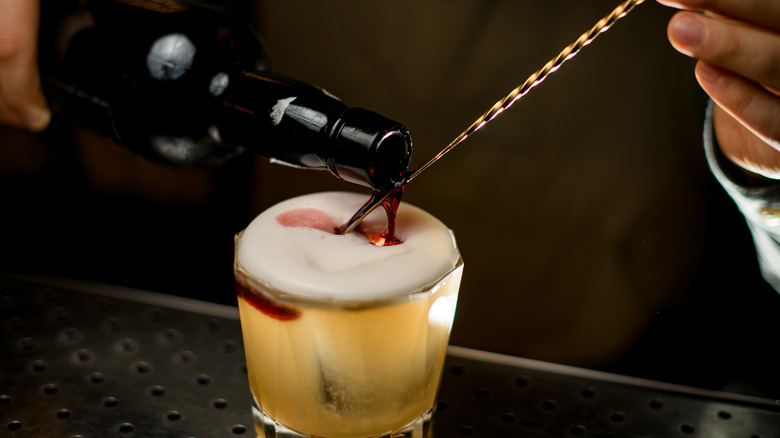What Does It Mean To Float A Liquid In A Cocktail?
Whether you want to add visual impact, make your cocktails extra boozy, or even set your drink on fire, floating a liquid in a cocktail can serve as a fun addition to many drinks. Adding a float means adding liquid to the top of a drink or shot, using a method that keeps the added layer separate from the rest of the beverage.
Adding a float to a cocktail can largely be done for presentation purposes, such as when you want to set a drink ablaze. Adding a (highly flammable) high-proof spirit to the top of a shot allows it to quickly ignite and burn off — which can be a fun experience to watch when done safely and correctly. Presentation aside, there are also practical reasons for using this method. Not only does keeping a specific ingredient at the top of the glass help keep aromas close to your nose, but it also allows the drink to change and evolve as you sip it.
Floating a liquid is different from layering a drink, as a float is just one ingredient on top of a mixed beverage, while a layered shot or layered drink involves layering multiple ingredients in a glass. For example, a New York Sour is a cocktail that includes a red wine float, while a Tequila Sunrise is a layered drink.
How to add a float to a cocktail
Your goal when adding a float to a drink is to keep the added ingredient separate from the rest of the cocktail. One technique involves slowly pouring the final ingredient over the back of a bar spoon or small regular spoon. You'll want to place the spoon as close to the top edge of the drink as possible and against the rim of the glass, since the purpose of using this technique is to allow the liquid to come into contact with the drink slowly by minimizing the distance and speed of the fall.
Another technique requires a bar spoon with a spiral handle. Hold the spoon upside down over the drink (so that the flat part of the handle is as close to the drink as possible), and slowly pour the liquid down the spiral handle. Don't worry about keeping the handle close to the rim of the glass. If you're floating something carbonated, you'll need to use this method so that the bubbles can cling to the spiraled metal, which prevents it from bubbling over.
As important as these techniques are for non-frozen beverages, if you're adding a float to a frozen cocktail (say, a rum float to a tropical frozen piña colada), you can simply add the liquid directly to the top of the drink. The density of the frozen beverage will prevent the float from sinking, but you'll still want to pour it low and slow.
Tips for achieving the perfect float
It's essential to remember that not all liquids will float on the surface of another. Density is the determining factor here, so if you're experimenting with creating drinks with floaters without using a recipe, don't be discouraged if some liquids don't work as well as others. Denser liquids, such as surgery syrups, are more likely to sink, while light liquids like liquors are more likely to float. High-proof liquors like navy-strength rum or high-proof whiskey are less dense than standard-proof liquors.
Since the key to a properly executed float involves adding the liquid slowly, pouring from a full, heavy bottle is a lot more difficult than pouring from a lighter, emptier one. If the ingredient you want to add happens to be in a full bottle, you can always transfer a small amount to a container with a pour spout like a gravy boat, measuring cup, or cream pot. You can also consider putting a speed pourer (which is the small spout you'll find on most bottles behind a bar) to help you pour more evenly.
You don't want to go to the time and effort learning how to pour perfect layered shots only to have them ruined at the last minute. So once you've concocted your beverage, be careful when serving it to guests or even just moving it from your home bar to wherever you plan to enjoy it. Keep the drink as still as possible to prevent the float from sinking.


